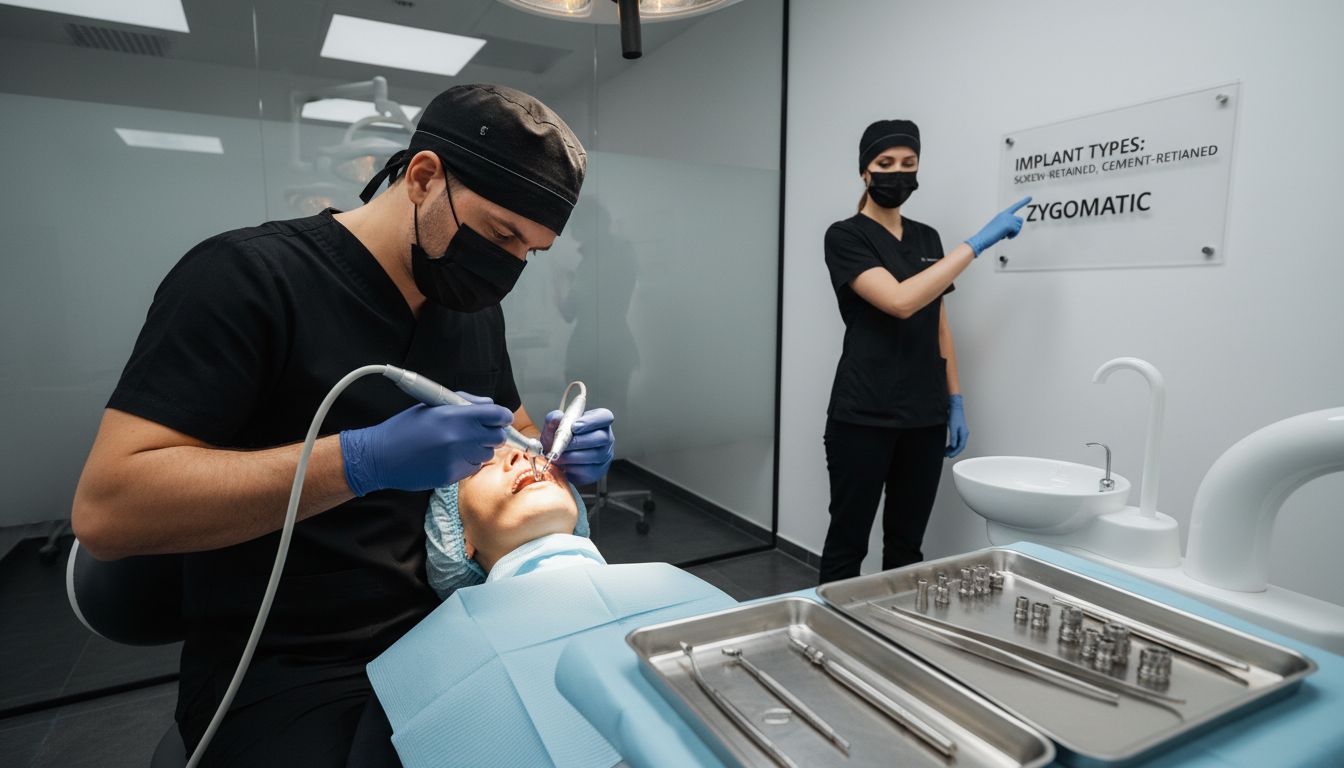Over three million people in the United States have chosen dental implants for lasting tooth replacement. Missing teeth can affect your confidence and make eating or speaking a challenge, but modern implant technology offers a solution that feels and looks just like natural teeth. By understanding the fundamental terms and how implant procedures work, you can make smarter decisions about your dental health and feel more prepared at every stage of the process.
Table of Contents
- Defining Dental Implant Terminology And Basics
- Types Of Dental Implants And Components
- Key Implant Procedures And Techniques Explained
- Materials And Surface Treatments In Implantology
- Common Risks, Aftercare, And Misconceptions
Key Takeaways
| Point | Details |
|---|---|
| Understanding Components | Familiarize yourself with the key components of dental implants: the fixture, abutment, and prosthetic crown for effective restoration. |
| Types of Implants | Identify the three main types of dental implants—endosteal, subperiosteal, and transosteal—to choose the best option for individual needs. |
| Surgical Process | A thorough surgical process is essential, including assessments, precise placement, and post-surgical care for optimal integration and success. |
| Risk Awareness and Myths | Be aware of potential risks such as infection and implant failure, and debunk common myths regarding pain and accessibility associated with dental implants. |
Defining Dental Implant Terminology and Basics
Dental implants represent a sophisticated solution for replacing missing teeth, offering patients a permanent and natural-looking restoration. According to dentalcare.com, these advanced prosthetic devices are designed to restore both functional and aesthetic aspects of a patient’s smile by mimicking natural tooth roots.
At the core of dental implant understanding are several key components. Implant fixtures are titanium posts surgically placed into the jawbone, serving as artificial tooth roots. These fixtures provide a stable foundation for prosthetic crowns, which are custom-designed to match the patient’s existing teeth in shape, color, and alignment. The Academy of Prosthodontics defines these components as critical elements in modern dental reconstruction techniques.
The dental implant process involves multiple stages and specialized terminology. Osseointegration is a critical biological process where the titanium implant fuses directly with living bone tissue, creating an incredibly strong and permanent connection. This scientific phenomenon ensures the implant becomes a functional part of your jaw structure, providing stability comparable to natural tooth roots. Patients considering implants should understand that successful osseointegration requires proper surgical technique, high-quality implant materials, and appropriate post-surgical care.
Understanding these fundamental terms and processes helps patients make informed decisions about their dental restoration options. For a comprehensive overview of your specific implant procedure, explore our detailed guide on dental implant surgery.
Types of Dental Implants and Components
Dental implants represent a sophisticated range of prosthetic solutions, each designed to address specific patient needs and anatomical conditions. NCBI research highlights three primary types of dental implants: endosteal, subperiosteal, and transosteal implants, each offering unique advantages for tooth replacement.
Endosteal implants are the most common type, surgically placed directly into the jawbone. These implants typically resemble small screws and are made of biocompatible titanium. According to the ADI, these implants consist of three primary components: the fixture (root), the abutment, and the prosthetic crown. Subperiosteal implants provide an alternative for patients with insufficient bone density, positioned on top of the jawbone but underneath the gum tissue.
The components of dental implants are critical to their functionality and long-term success. Key elements include:
- Implant Fixture: The titanium post surgically inserted into the jawbone
- Abutment: A connecting piece that links the fixture to the prosthetic tooth
- Prosthetic Crown: The visible tooth-like restoration that mimics natural teeth
Explore our comprehensive guide on different types of dental implants to understand which option might best suit your specific dental restoration needs. Each implant type offers unique benefits, and selecting the right approach depends on individual patient factors like bone density, overall oral health, and specific restoration requirements.
![]()
Key Implant Procedures and Techniques Explained
Dental implant procedures represent a complex and precise medical intervention that requires meticulous planning and execution. NCBI research highlights the intricate steps involved in successful implant placement, emphasizing the importance of comprehensive patient assessment and advanced surgical techniques.
The implant procedure typically follows a structured approach. Initial consultation involves comprehensive oral examinations, including detailed imaging like CT scans and X-rays to evaluate bone density and structure. According to the ADI, surgical planning is critical and includes:
- Precise measurement of jawbone dimensions
- Evaluation of patient’s overall oral health
- Selection of appropriate implant type and size
- Determination of optimal implant placement strategy
Surgical placement represents the most critical phase of the implant procedure. This involves creating a small incision in the gum tissue, carefully drilling a precise hole in the jawbone, and inserting the titanium implant fixture. The procedure requires exceptional surgical skill to ensure minimal tissue damage and optimal implant positioning. Healing and osseointegration follow, where the implant gradually fuses with the surrounding bone tissue, typically requiring 3-6 months of recovery.

Learn more about preparing for your dental implant surgery to understand the comprehensive steps and considerations involved in this transformative dental restoration process. Each stage demands precision, expertise, and personalized patient care to ensure successful long-term outcomes.
Materials and Surface Treatments in Implantology
Dental implant materials represent a sophisticated intersection of medical engineering and materials science, with continuous advancements improving patient outcomes. PMC research highlights the critical importance of selecting appropriate biomaterials that can successfully integrate with human biological systems.
Titanium remains the gold standard in implant materials, prized for its exceptional biocompatibility and strength. Pocketdentistry explains that modern implants often utilize specific titanium alloys engineered to enhance performance. Surface treatments play a crucial role in implant success, with techniques designed to improve integration and long-term stability:
- Sandblasted surfaces to increase microscopic roughness
- Acid-etched treatments to enhance cellular attachment
- Plasma-sprayed coatings for improved bone bonding
- Hydroxyapatite coating to stimulate faster osseointegration
Beyond traditional metals, researchers are exploring advanced biomaterials including:
- Zirconia ceramics
- Bioactive glass composites
- Polymer-based hybrid materials
Discover what dental professionals aren’t telling you about implant materials to understand the nuanced world of modern implant technology. Each material and surface treatment represents a carefully engineered solution designed to provide patients with durable, natural-feeling dental replacements.
Common Risks, Aftercare, and Misconceptions
Dental implant procedures, while highly successful, are not without potential complications. NCBI research emphasizes the importance of understanding potential risks and implementing comprehensive preventative strategies to ensure optimal outcomes.
Potential risks associated with dental implants include:
- Infection: The most common complication, often resulting from poor oral hygiene
- Implant failure: Occurs when the implant does not properly integrate with bone tissue
- Nerve damage: Rare but possible during surgical placement
- Sinus complications: Particularly with upper jaw implants
According to the ADI, many misconceptions surround dental implants. Common myths include beliefs that implants are painful, prohibitively expensive, or only suitable for younger patients. In reality, modern implant techniques have made the procedure more accessible, comfortable, and successful across various age groups.
Discover how to heal faster after dental implants and understand the critical aftercare steps that can significantly improve your implant success. Proper post-surgical care, including meticulous oral hygiene, following your dentist’s recommendations, and attending regular check-ups, remains the cornerstone of long-term implant health and functionality.
Understand Your Dental Implants with Confidence and Care
Navigating dental implant terminology can feel overwhelming when you are facing important choices about your oral health. Terms like osseointegration, abutment, and implant fixtures represent critical steps and components in achieving a natural, lasting smile. At DentalAteliers.com, we understand these challenges and are here to guide you through every detail with clear information and compassionate support. Our patient-centered approach ensures you feel comfortable and informed as you explore advanced treatments like All-on-4 implants and full-arch zirconia restorations.

Take control of your dental journey today by visiting Dental Ateliers. Discover how our expert team led by Dr. Kunal Narang combines cutting-edge implant techniques with personalized care to deliver results that truly transform lives. Don’t wait to restore your confidence and smile. Schedule your consultation now and experience dental implant solutions tailored just for you. Learn more about your options at Dental implant surgery details and explore types of dental implants to find your best fit.
Frequently Asked Questions
What are the main components of a dental implant?
The main components of a dental implant include the implant fixture (titanium post), the abutment (connecting piece), and the prosthetic crown (visible tooth restoration). These elements work together to provide a strong and aesthetic solution for missing teeth.
What is osseointegration in dental implants?
Osseointegration is the biological process where the titanium implant fuses directly with the jawbone, creating a strong and stable connection that mimics the function of natural tooth roots. This process is critical for the success of dental implants.
What are the different types of dental implants available?
The three primary types of dental implants are endosteal implants, which are placed directly into the jawbone, subperiosteal implants, positioned on top of the jawbone under the gum tissue, and transosteal implants, which pass through the jawbone. Each type serves specific patient needs based on anatomy and bone density.
What are some common risks associated with dental implants?
Common risks associated with dental implants include infection, implant failure due to poor integration with bone, nerve damage during surgery, and sinus complications for upper jaw implants. Proper surgical technique and post-operative care are crucial to minimize these risks.


.svg)